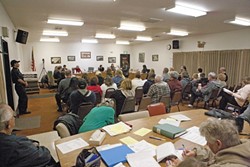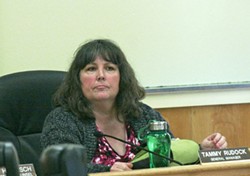It was easy to tell they weren’t used to strangers.
It got quiet when a New Times reporter walked into the San Miguel Community Services District office on the windswept, barren main street of the quiet North County town. A few CSD workers stared into a computer screen and stopped talking when the stranger entered.

- PHOTO BY STEVE E. MILLER
- DYSFUNCTIONAL : Since this Oceano Board of Directors meeting in February, two board members have been replaced and a general manager fired.
“Can I help you?” asked the receptionist.
“Can I take a look at the agendas of this year’s board meetings?”
She handed the reporter a thick binder and went back to talking with another employee. There was only one agenda in the binder.
“I’ll look for some more,” she said grumpily.
She eventually printed out hundreds of pages of district documents. Buried deep in the stack of reports was a single line, a needle in a haystack of mind-numbingly obscure government text.
“Employee terminated, District Counsel has referred particulars to the County DA office,” it read.
Bingo.
Sources tell New Times that a former employee of the San Miguel CSD is being investigated for embezzlement.
This may sound like big news, but it really isn’t. CSDs lose track of money all the time, and, in all likelihood, few people will notice if someone stole money from an obscure services district. None of the San Miguel officials called or e-mailed by New Times responded.
In fact, people familiar with San Miguel finances say it may be impossible to find out if money was stolen or disappeared into a fog of incompetent bookkeeping.
Like many of the CSDs in San Luis Obispo County, San Miguel isn’t very good at financial bookkeeping. A state-mandated audit of the last financial year hasn’t been done. In fact, a New Times investigation found that most CSDs don’t bother to comply with state finance laws.
CSDs are not just financially loopy—many of them are full-blown crazy. In government circles, CSDs are the screwball comedies of the small government world. To many observers, many of them are off the wall as hell. Meetings can be crazy and odd. Suspect finances are common. Executives often operate the districts like their own fiefdoms with little accountability.
Many of the districts are small and attract little notice, even by the people who have to support them with their taxes. No one takes much notice of what goes on in these obscure fiefdoms, and most media outlets don’t bother to report on them.
“They’re not big on keeping track of money over here,” said a man who owns a shop down the street from the San Miguel district office. He didn’t want his name published: “It’s a small town, you know.”
Living free and easy
CSDs represent small communities that aren’t big enough to be towns. There are 11 such districts in SLO County, and they encompass most of the unincorporated communities. CSDs are a lot like towns, except they do a lot less. They usually take care of water and sewer services, though some districts do more and some don’t do even that much.
Larger CSDs like Oceano, Cambria, and Los Osos operate and feel like a city hall in all but name. They have staffs and meeting halls and are the civic heart of their communities. Others—like San Miguel, Heritage Ranch, and California Valley—only operate limited hours and are essentially tiny public utility companies.
What they all have in common is a unique level of independence. Each of them operates as a separate legal entity and is essentially accountable to no one. There are few federal, state, or county laws that restrict or control CSD behavior. On the local level, only the county auditor-controller has any oversight responsibility, which is to receive and file yearly audits of their finances.
Freedom from oversight
If you look to the county website to find out information on the districts, you’re making a mistake. One page dedicated to CSDs only lists eight of the 11 districts. Another page lists four. Some of the links to the districts are dead.
State law requires CSDs to audit their books once a year and send the results to the county assessor and California State Controller. A 2007 study conducted by the county found that most of the districts didn’t send audit reports to either.
Gere Sibbach, the county auditor-controller, said two CSDs—Oceano and San Simeon—haven’t turned in audits in two years. Seven other CSDs were more than a year late in turning over their audits for the last fiscal year. He said he finds this disturbing, but there isn’t much he can do.

- PHOTO BY MATT FOUNTAIN
- TORCHES AND PITCHFORKS : Former Cambria Community Services District general manager Tammy Rudock (pictured) sat an April 28 board of directors meeting, approximately 24 hours before being canned. Not pictured are the approximately 300 residents calling for her immediate termination.
“All we can do is write them letters,” Sibbach said. “There is no enforcement mechanism to make them comply with the statute.”
State law once gave counties the authority to make CSDs keep their finances in order, but that was rescinded years ago, he said.
The county does have a role in the district finances; it collects property taxes and sends a portion of that back to the districts, Sibbach said.
“CSDs are really independent,” he said. “They pretty much do their own thing.”
Something odd going on beyond the eastern horizon
Just because an organization’s books aren’t in order or up to date doesn’t mean someone is skimming off the top.
That’s a standard CSD bureaucrat refrain. And while it may be true, some CSDs in this county have had a tendency toward embezzlement—or at least suspicious behavior.
A San Miguel CSD employee was convicted of embezzling $43,700 from the district in 2005. Between 2000 and 2003, an employee stole more than $300,000 from the California Valley Services District before auditors realized something was amiss. Other CSDs have had mystery gaps in their books that were never accounted for.
The California Valley CSD provides road maintenance and solid waste pick-up and disposal for a barren, desolate valley 56 miles east of San Luis Obispo. The district provides service for 450 people.
The district’s population has a reputation for enjoying independence.
“They’re the kind of people who don’t like people,” a county official said, describing the valley’s inhabitants. “They don’t care for outsiders looking around their business.”
The CSD there has been investigated three times by the county grand jury. The last grand jury report was released in 2007 and found no evidence of unlawful conduct but did state that the district should “improve overall management and operations.”
Recently, the district’s board of directors has been in negotiations to sell three pieces of district land to Topaz Solar Farms and High Planes Ranch, two energy companies that have proposed to build large solar arrays on property outside the district. The solar companies need land in the area to meet a county requirement for building solar arrays on the Carrizo Plains: For every acre the companies use for energy production, they must have five acres set aside to keep in a natural state.
At the same time the land negotiations have been taking place, the district accepted $25,000 from SunPower, the company building High Plains Ranch, toward district building maintenance. The district accepted a donation from First Solar, the company building Topaz Solar Farms, for up to $25,000 to help provide power for a future district park. The acceptance of the First Solar donation directly followed a closed-door meeting discussing the sale of the property.
When asked about conducting closed-door negotiations concerning a property sale while accepting a company donation at the same time, county officials said they hadn’t heard of the incident and were mystified by it. They said the two solar projects will be constructed outside of the CSD’s territory and didn’t understand why the companies would be dealing with the CSD.
“I can see them buying [the district] something, just to smooth things out,” said a county official. “The property buys and the donation seem pretty odd, to say the least.”
Turmoil among the pines
Perhaps no recent tale highlights the sheer wackiness a CSD is capable of than what went down in Cambria over the last few months. If ever there was an example of a small community raising the torches and pitchforks against its own CSD chief administrator, Cambria may be it. In fact, it could become a textbook case study of how not to manage a services district.
Tammy Rudock, the wildly unpopular former general manager for Cambria’s CSD, was fired from her top spot April 29 due to long-smoldering resentment of her astronomical pay and cushy benefits, dissatisfaction with the district’s customer service, and her reputation as an über micromanager.
Rudock’s story extends back to 2002, when she was hired by the CSD board of directors as assistant general manager. At the time, she was clearly being groomed for the top spot, soon to be vacated by former general manager Vern Hamilton. Her previous experience at that point was as assistant director for water and sewer services for the city of Shreveport, LA, from 1994 to 1999, and a brief stint as public works director for the city of Coalinga from 1999 to 2002.
New Times filed public records requests with both cities for verification of employment and terms of dismissals. Both cities verified that Rudock was employed by them in the various roles, but wouldn’t release any other specifics, citing personnel confidentiality.
Then there was the issue of pay. For administering one of the smallest communities in the county, Rudock had the largest salary of any CSD manager—and even gave SLO City Manager Katie Litchig a run for her money, when comparing per capita pay.
The average salary for a special district general manager in California is $110,419, according to information provided by the California Special Districts Association. In SLO County, that average was $112,711.
That average was tipped to the high end by Rudock’s uncommon salary. Since her contract was renewed in July 2007, she was reeling in a whopping $166,538—actually $231,000 including health and other benefits—per year. Rudock also enjoyed such perks as phone compensation, gas allowances, and a housing allowance to live in Cambria—all to manage the services of a town of roughly 6,500 residents.
Though Rudock couldn’t be reached for comment on this article, she previously told New Times that her living in Cambria was a condition of her employment, a notion denied by former board chair Greg Sanders.
Residents also frequently complained about Rudock’s salary and perks, especially given the fact that district office hours are limited to 10 a.m. to 3 p.m., Monday through Thursday, and calls to Rudock regarding service were allegedly met with rudeness or sometimes ignored completely.
Things came to a head for Rudock the day she fired Mark Miller, the popular chief of Cambria’s fire department.
Though Rudock wouldn’t disclose to the public her reasons for firing Miller, citing personnel confidentiality, Miller would later provide the Tribune with a memo outlining her reasons, which included allegedly not keeping her enough in the loop during the April tsunami warning, failing to keep employee evaluations up to date, and what she saw as a lack of respect for her authority.
In the weeks following Miller’s ouster, signs and mass e-mails began circulating around town, culminating in literally hundreds of residents showing up to a board meeting April 28, threatening the directors that voters would remember how they handled the Rudock fiasco come the next board election.
The very next day, the jittery board announced they had unanimously decided to give Rudock the boot. And they’d reinstate Miller. Utilities Manager Jerry Gruber is expected to soon take the helm, but Rudock will continue to collect nearly a year’s worth of severance pay.
Chaos by the dunes
If there is one thing you can count on when you walk into the Oceano CSD board room, it’s that you’re going to meet some really pissed off people. No matter what the subject is, the Oceano residents who show up are nearly always angry and willing to constantly express what’s on their minds.
The CSD’s board of directors historically puts on a show of bumbling incompetence, a complete lack of fiscal understanding, and a stunning disregard of the Brown Act, the state codes that ensure open and public meetings.
The board’s behavior often stirs the residents to angry outbursts, resulting in shouting and an occasional thrown chair.
Directors get in the act, too. They’ve been known to shout at each other, occasionally sue each other, and, when the urge strikes them, mumble into a microphone so no one can hear a fellow board member speak in opposition. The directors sometimes cut speakers off or forget to ask for public comment at all.
The subject of most of the discussions is money. Until recently, the Oceano board didn’t know how much money the district had. The financial books are so screwed up that district officials say they don’t know if anyone will ever know what went on with the finances during the last three years. In August 2010, officials discovered $368,000 in district funds tucked away in previously unknown accounts. Some directors say a sizable chunk of money—one ex-director thought the figure might be in the high six figures—was siphoned off by employees. Others think money might have been used to help homeowners repair their houses after the 2004 earthquake.
The frustrating part of this mystery for Oceano residents is that it’s doubtful anyone will ever know what happened.
A forensic audit of a small section of the 2008-09 fiscal year found that more than 30 percent of the financial transactions examined were deemed “questionable.” A past board of directors decided not to investigate further after the District Attorney’s Office seemed to lose interest.
A common sentiment among Oceano residents is the district is fleecing their pocket books and giving little in return. A veteran of Oceano board meetings whispered some advice to a New Times reporter at the beginning of his first visit to a board meeting: “When you come to these meetings, hold on to your wallet, kid.”
The latest board of directors seems determined to make things right. The board recently fired Raffaele Montemurro, the latest general manager. Montemurro was hired to clean up the district after years of financial mismanagement, but he never seemed to get a grasp of the budget and had developed a habit of not listening to the board. Since he was fired May 31, three district employees have left and the board voted to change the locks at the district office. Whether because there isn’t enough office staff left or the ones that are left aren’t considered trustworthy, one of the directors has to open and close the office on workdays.
The jury is still out on whether the changes at Cambria and Oceano will make a turning point in the wacky world of CSDs, but it does seem that change is in the air.
Felma Hurdle, a no-nonsense, retired prison guard who was recently appointed to the Oceano board, said she’s determined to help rid her district of the stigma that clings to Oceano.
“I believe the whole board is dedicated to getting things upright,” said Hurdle. “We need to get an absolute transparent hold on the finances. We may fail but it won’t be because we didn’t try.”
Staff Writers Robert A. McDonald and Matt Fountain can be reached at [email protected].


Comments